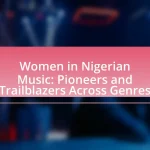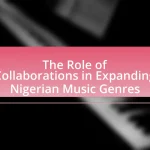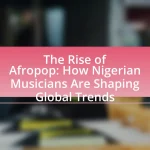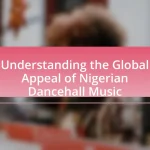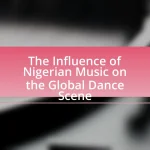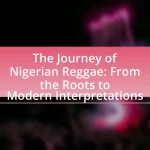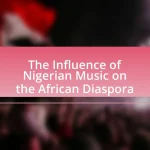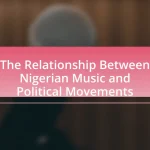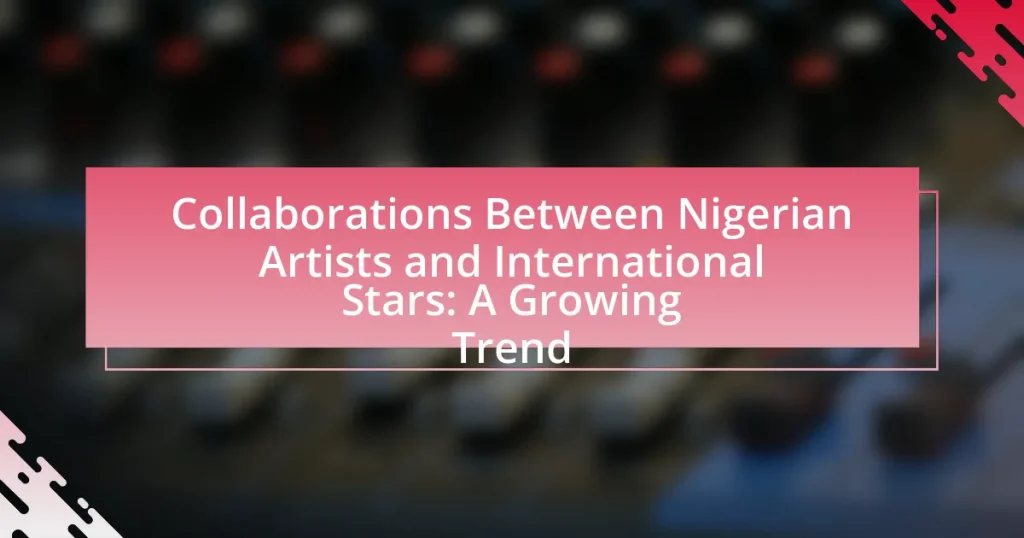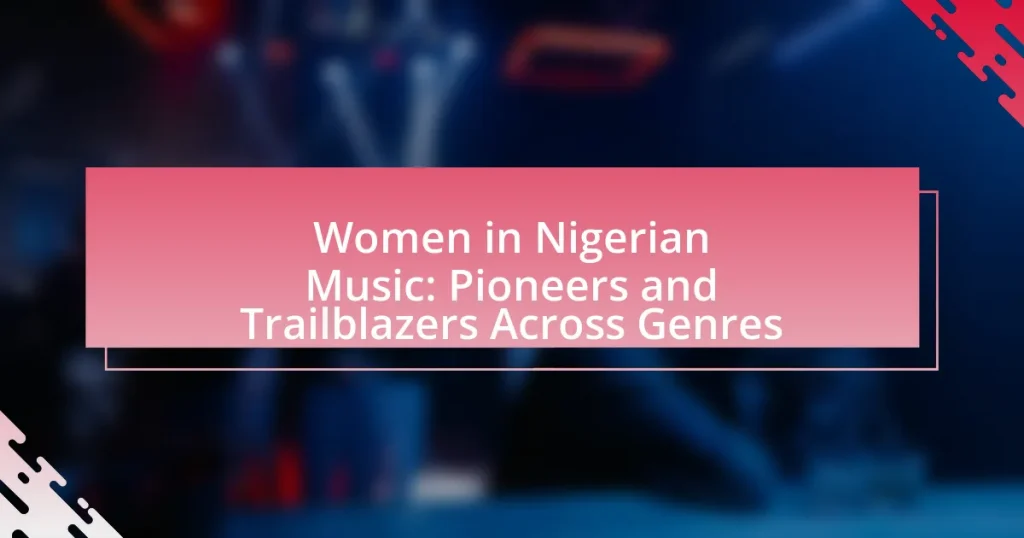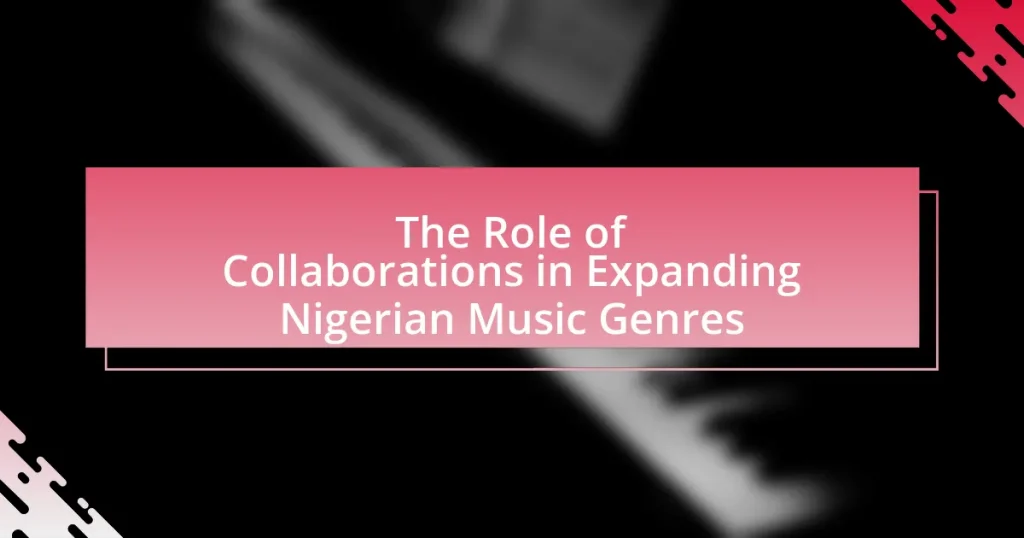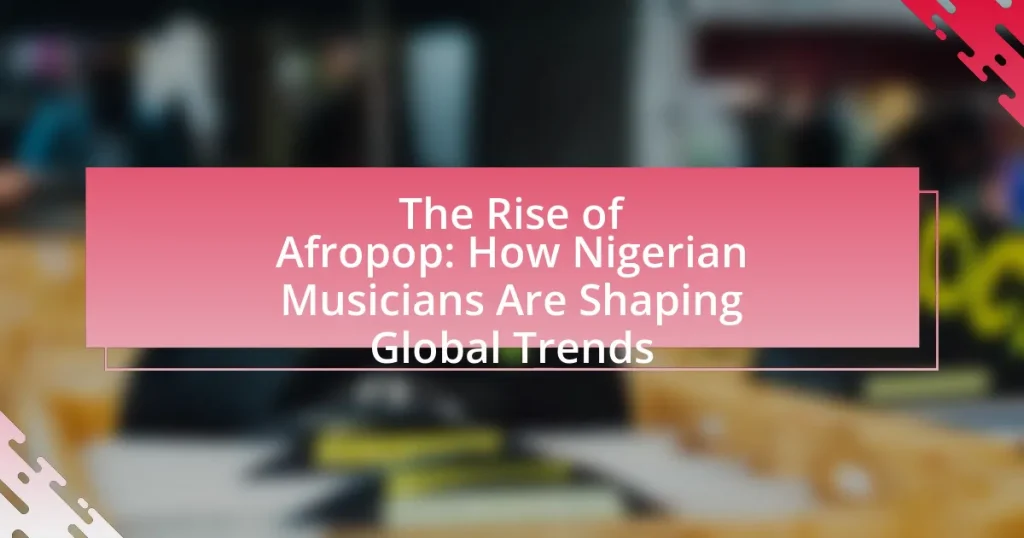Collaborations between Nigerian artists and international stars represent a significant trend in the music industry, characterized by joint projects that merge diverse cultural influences and broaden audience reach. This article explores the evolution of these collaborations over the past two decades, highlighting key partnerships such as Wizkid’s work with Drake and Burna Boy’s features with global icons. It examines the historical factors that have facilitated these collaborations, including globalization and technological advancements, while also addressing the challenges faced by artists in cross-border projects. Additionally, the article discusses the impact of these collaborations on cultural exchange, the global perception of Nigerian music, and the future trends shaping this dynamic landscape.
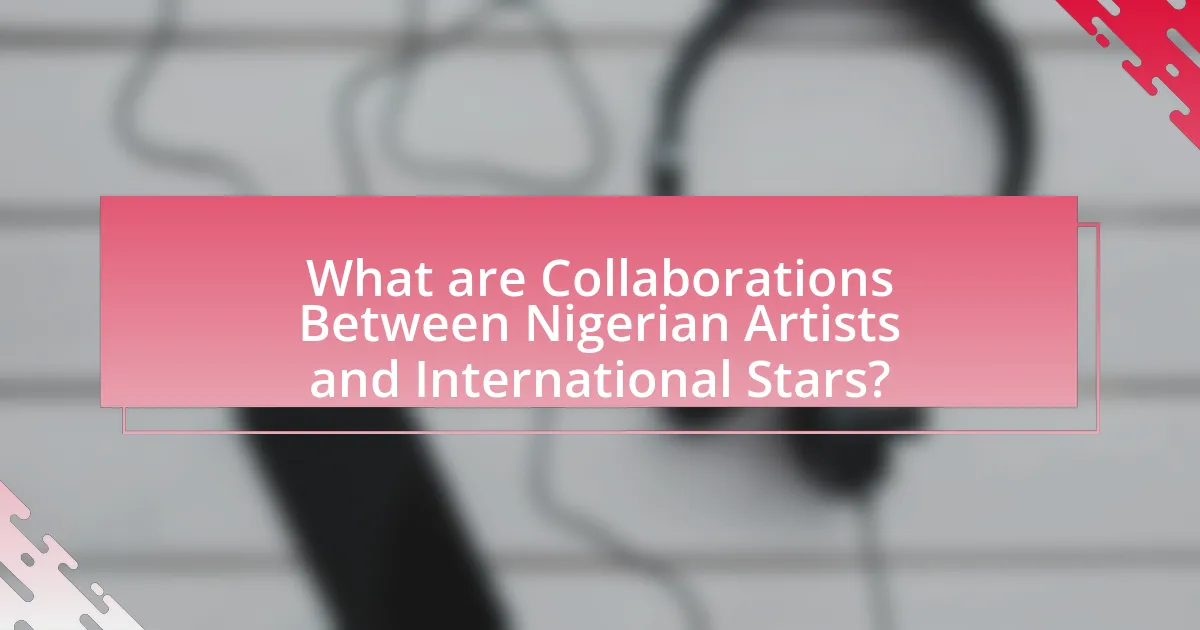
What are Collaborations Between Nigerian Artists and International Stars?
Collaborations between Nigerian artists and international stars involve joint musical projects that blend diverse cultural influences and expand audience reach. These partnerships have gained prominence, with notable examples including Wizkid’s collaboration with Drake on “One Dance,” which topped charts globally, and Burna Boy’s feature on Beyoncé’s “The Lion King: The Gift” album, showcasing the fusion of Afrobeat with mainstream pop. Such collaborations not only enhance the visibility of Nigerian music but also contribute to the global appreciation of African culture, as evidenced by the increasing number of Nigerian artists featured in international music festivals and award shows.
How have these collaborations evolved over time?
Collaborations between Nigerian artists and international stars have evolved significantly over the past two decades. Initially, these partnerships were sporadic and often limited to a few high-profile artists, such as 2Baba and Akon, who collaborated in the early 2000s, marking the beginning of a trend. As the Nigerian music industry gained global recognition, particularly with the rise of Afrobeats, collaborations became more frequent and diverse, involving a wider range of genres and artists.
By the 2010s, artists like Wizkid and Burna Boy collaborated with major international acts such as Drake and Ed Sheeran, showcasing the growing acceptance and integration of Nigerian music in the global market. This evolution is evidenced by the increasing number of chart-topping hits that feature Nigerian artists alongside international stars, reflecting a shift in the music industry’s dynamics and audience preferences. The trend continues to grow, with more collaborations being announced and produced, indicating a sustained interest in cross-cultural musical exchanges.
What historical factors contributed to the rise of these collaborations?
The rise of collaborations between Nigerian artists and international stars is primarily attributed to globalization and the digital revolution. Globalization has facilitated cultural exchange, allowing Nigerian music to reach wider audiences, while the digital revolution has provided platforms like social media and streaming services for artists to connect and collaborate across borders. For instance, the success of Nigerian genres such as Afrobeats has led to partnerships with global artists, exemplified by collaborations like Wizkid and Drake’s “One Dance,” which topped charts worldwide. This trend reflects a significant shift in the music industry, where cross-cultural collaborations are increasingly common, driven by the desire for diverse sounds and broader market reach.
How has technology influenced the collaboration process?
Technology has significantly influenced the collaboration process by enabling seamless communication and real-time collaboration across geographical boundaries. Tools such as video conferencing, cloud storage, and collaborative software have allowed artists from Nigeria and international stars to work together more efficiently, regardless of their physical locations. For instance, platforms like Zoom and Google Drive facilitate instant sharing of ideas and materials, which accelerates the creative process. Additionally, social media platforms have expanded the reach of artists, allowing them to connect and collaborate with a global audience, thus fostering a more diverse and inclusive music scene.
Why are these collaborations significant in the music industry?
Collaborations between Nigerian artists and international stars are significant in the music industry because they enhance cultural exchange and broaden market reach. These partnerships allow Nigerian artists to gain exposure to global audiences, as evidenced by the success of tracks like “Essence” by Wizkid featuring Tems, which topped charts internationally and garnered millions of streams. Additionally, such collaborations often lead to increased revenue opportunities, as artists can tap into each other’s fan bases, exemplified by Burna Boy’s collaboration with Ed Sheeran on “For My Hand,” which further solidified Afrobeat’s presence in mainstream music. This trend not only elevates the profiles of Nigerian artists but also enriches the global music landscape by blending diverse musical styles and influences.
What impact do they have on cultural exchange?
Collaborations between Nigerian artists and international stars significantly enhance cultural exchange by facilitating the sharing of diverse musical styles and cultural narratives. These partnerships allow for the blending of traditional Nigerian sounds, such as Afrobeats, with global genres like hip-hop and pop, creating a rich tapestry of music that resonates across different cultures. For instance, the collaboration between Wizkid and Drake on the track “One Dance” not only popularized Afrobeats in the Western music scene but also introduced listeners to Nigerian culture and its artistic expressions. This cross-cultural interaction fosters greater understanding and appreciation of different cultural backgrounds, ultimately enriching the global music landscape.
How do they affect the global perception of Nigerian music?
Collaborations between Nigerian artists and international stars significantly enhance the global perception of Nigerian music. These partnerships introduce Nigerian sounds to broader audiences, showcasing the genre’s diversity and richness. For instance, collaborations like Wizkid’s work with Drake on “One Dance” and Burna Boy’s feature on Beyoncé’s “The Lion King: The Gift” album have propelled Nigerian music into mainstream global charts, leading to increased recognition and appreciation. This trend not only elevates the artists involved but also fosters cultural exchange, positioning Nigerian music as a vital player in the global music landscape.
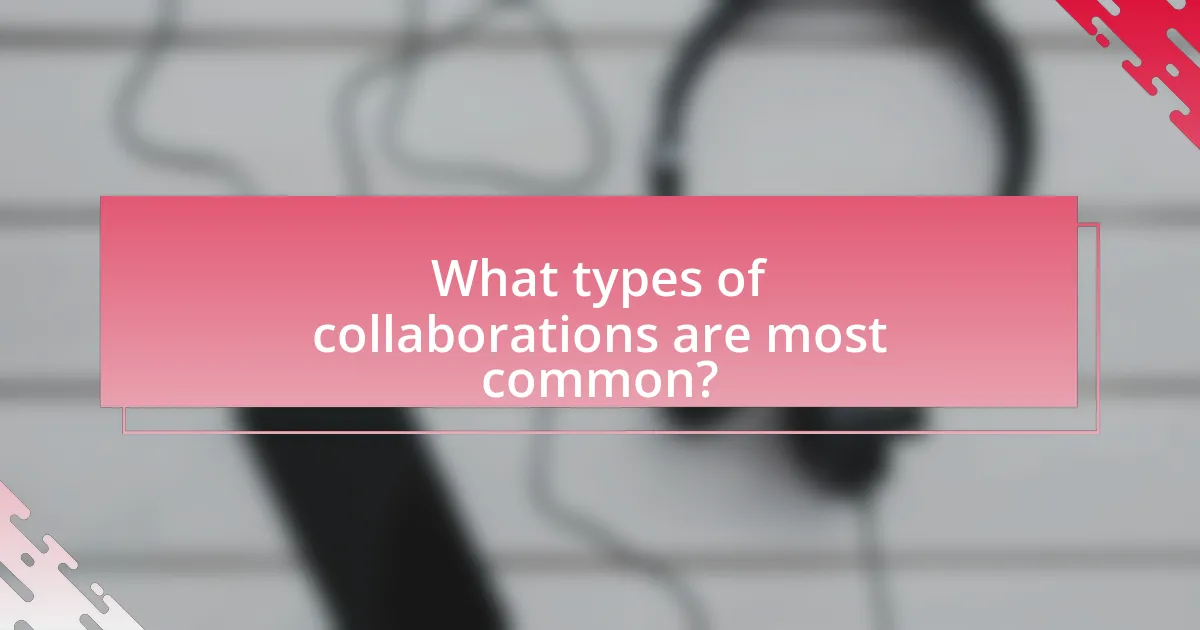
What types of collaborations are most common?
The most common types of collaborations between Nigerian artists and international stars include musical features, joint albums, and cross-genre projects. Musical features involve Nigerian artists collaborating with international musicians on singles, which allows for a blend of styles and wider audience reach. Joint albums are less frequent but showcase a collection of works from both artists, enhancing cultural exchange. Cross-genre projects often merge Afrobeat with genres like hip-hop or R&B, reflecting the global influence of Nigerian music. These collaborations have gained traction due to the increasing popularity of Afrobeat worldwide, evidenced by Nigerian artists like Burna Boy and Wizkid achieving significant chart success alongside international acts.
How do collaborations differ across genres?
Collaborations differ across genres primarily in their stylistic approaches and target audiences. For instance, hip-hop collaborations often emphasize lyrical prowess and feature multiple artists to showcase diverse perspectives, while pop collaborations may focus on catchy melodies and broad commercial appeal, often involving high-profile artists to maximize reach. In contrast, genres like jazz prioritize improvisation and musical synergy, leading to collaborations that highlight instrumental skills and artistic expression. This variance is evident in the growing trend of Nigerian artists collaborating with international stars, where the fusion of Afrobeats with genres like R&B or hip-hop creates unique soundscapes that attract diverse listeners, reflecting the blending of cultural influences and musical styles.
What are some notable examples in Afrobeats?
Notable examples in Afrobeats include the collaboration between Wizkid and Drake on the track “One Dance,” which topped charts globally and showcased the genre’s international appeal. Another significant example is Burna Boy’s partnership with American artist Khalid on “Location,” which further solidified Afrobeats’ presence in mainstream music. Additionally, the song “Essence” by Wizkid featuring Tems gained widespread acclaim and was recognized as a pivotal moment for Afrobeats in the global music scene, even charting on the Billboard Hot 100. These collaborations illustrate the growing trend of Nigerian artists working with international stars, enhancing the genre’s visibility and influence.
How do hip-hop collaborations showcase diversity?
Hip-hop collaborations showcase diversity by bringing together artists from various cultural backgrounds, musical styles, and geographic locations. These partnerships often blend different influences, such as traditional African rhythms with contemporary hip-hop beats, exemplified by collaborations like Burna Boy and J Balvin’s “Location,” which merges Afrobeat with reggaeton. Such collaborations not only highlight the unique contributions of each artist but also promote cross-cultural understanding and appreciation, as seen in the increasing number of Nigerian artists collaborating with international stars, reflecting a globalized music scene. This trend is supported by data indicating that collaborations can lead to increased streaming numbers and broader audience reach, demonstrating the commercial viability and cultural significance of diverse musical partnerships.
What roles do producers and songwriters play in these collaborations?
Producers and songwriters play crucial roles in collaborations between Nigerian artists and international stars by shaping the sound and lyrical content of the music. Producers are responsible for the overall sound production, including arranging, mixing, and mastering tracks, which ensures that the final product meets industry standards and appeals to a global audience. For instance, renowned producers like Sarz and Don Jazzy have successfully blended Afrobeat with various genres, enhancing the international appeal of Nigerian music.
Songwriters contribute by crafting lyrics and melodies that resonate with diverse audiences, often incorporating cultural elements that reflect the artists’ backgrounds. This collaboration allows for a fusion of styles, as seen in projects like Wizkid’s “Essence,” which features contributions from both Nigerian and international songwriters, resulting in a track that gained worldwide acclaim. Thus, the synergy between producers and songwriters is essential for creating music that bridges cultural gaps and reaches a broader market.
How do they influence the sound and style of the music?
Collaborations between Nigerian artists and international stars significantly influence the sound and style of music by blending diverse musical elements and cultural influences. This fusion often results in unique genres, such as Afrobeats, which incorporates traditional African rhythms with global music styles like hip-hop, R&B, and dancehall. For instance, the collaboration between Wizkid and Drake on the track “One Dance” showcases how Nigerian rhythms can enhance mainstream pop music, leading to widespread appeal and chart success. Such partnerships not only expand the sonic palette but also introduce new lyrical themes and production techniques, thereby reshaping the global music landscape.
What are the challenges faced by producers in cross-border collaborations?
Producers in cross-border collaborations face several challenges, including cultural differences, legal complexities, and logistical issues. Cultural differences can lead to misunderstandings in artistic vision and communication styles, impacting the collaboration’s effectiveness. Legal complexities arise from varying copyright laws and contract enforcement across countries, which can complicate rights management and revenue sharing. Logistical issues, such as coordinating schedules and managing time zone differences, can hinder project timelines and overall collaboration efficiency. These challenges are significant as they can affect the quality and success of the collaborative efforts between Nigerian artists and international stars.
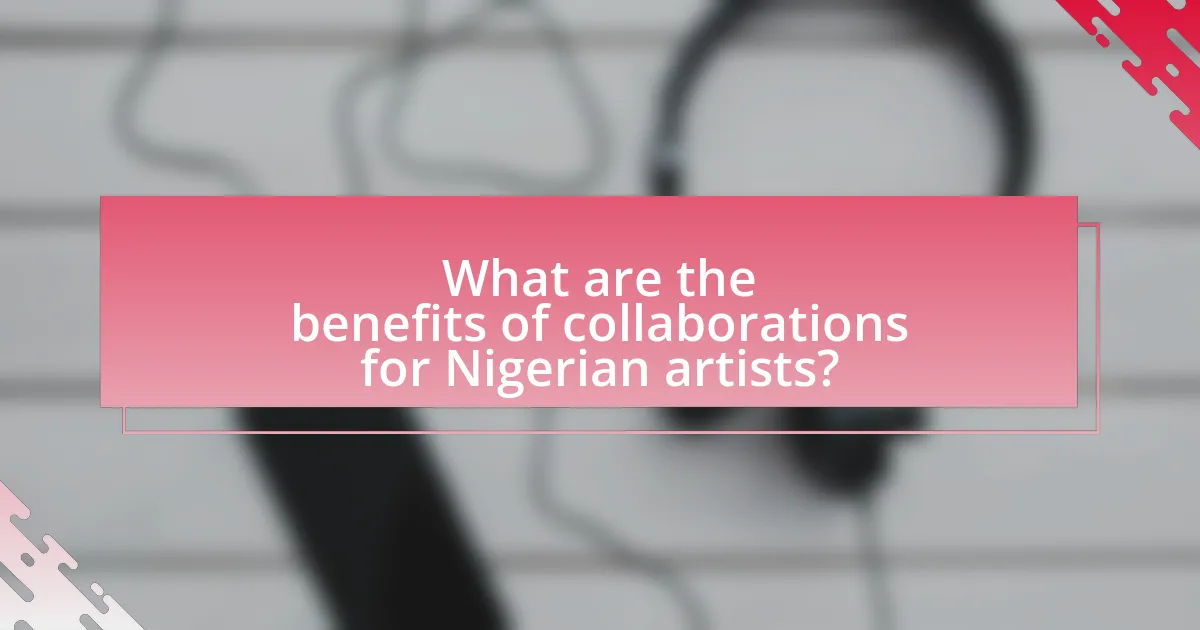
What are the benefits of collaborations for Nigerian artists?
Collaborations provide Nigerian artists with increased exposure and access to international markets. By partnering with global stars, Nigerian musicians can tap into their collaborators’ fan bases, significantly expanding their audience reach. For instance, the collaboration between Wizkid and Drake on the song “One Dance” not only boosted Wizkid’s visibility but also contributed to the global success of Afrobeats, showcasing the genre on a larger scale. Additionally, collaborations often lead to enhanced creative opportunities, allowing artists to experiment with different styles and genres, which can result in innovative music that resonates with diverse audiences.
How do these partnerships enhance an artist’s reach?
Partnerships between Nigerian artists and international stars enhance an artist’s reach by expanding their audience and increasing visibility across global markets. These collaborations often result in cross-cultural exposure, allowing Nigerian artists to tap into the fan bases of their international counterparts, which can lead to increased streaming numbers and social media engagement. For instance, the collaboration between Wizkid and Drake on the track “One Dance” significantly boosted Wizkid’s international profile, resulting in his music reaching audiences in North America and Europe, evidenced by the song topping charts in multiple countries. Such partnerships not only elevate an artist’s brand but also facilitate access to new platforms and promotional opportunities, further amplifying their global presence.
What opportunities arise from international exposure?
International exposure provides Nigerian artists with opportunities for global collaboration, increased visibility, and access to diverse markets. Collaborating with international stars allows Nigerian artists to blend cultural influences, enhancing their creative output and appeal. This exposure can lead to participation in international festivals and events, which further amplifies their reach and audience engagement. Additionally, statistics show that artists who engage in international collaborations often experience a significant increase in streaming numbers and social media following, indicating a broader fan base and potential revenue growth.
How do collaborations contribute to an artist’s brand development?
Collaborations significantly enhance an artist’s brand development by expanding their audience reach and increasing visibility. When artists partner with others, especially those from different genres or regions, they tap into new fan bases, which can lead to increased sales and streaming numbers. For instance, the collaboration between Nigerian artist Wizkid and American singer Drake on the track “One Dance” not only topped charts globally but also introduced Wizkid to a wider international audience, solidifying his brand as a global artist. This strategic partnership illustrates how collaborations can elevate an artist’s profile, foster cross-cultural connections, and ultimately contribute to their brand’s growth in the competitive music industry.
What challenges do Nigerian artists face in international collaborations?
Nigerian artists face several challenges in international collaborations, including cultural differences, logistical issues, and financial constraints. Cultural differences can lead to misunderstandings in artistic vision and collaboration dynamics, impacting the final product. Logistical issues often arise from varying time zones, communication barriers, and the need for travel, which can complicate the collaboration process. Financial constraints, such as limited budgets for production and marketing, can hinder the ability of Nigerian artists to compete on a global scale. These challenges are significant as they can affect the quality and success of international projects involving Nigerian artists.
How do cultural differences impact the collaboration process?
Cultural differences significantly impact the collaboration process by influencing communication styles, decision-making approaches, and conflict resolution strategies. For instance, in collaborations between Nigerian artists and international stars, Nigerian artists may prioritize communal values and indirect communication, while international collaborators might favor individualism and directness. This divergence can lead to misunderstandings or misinterpretations during the creative process. Research indicates that effective cross-cultural collaboration requires awareness and adaptation to these differences, as highlighted in the study “Cultural Intelligence and Team Performance: The Role of Cultural Diversity” by Ang et al. (2007), which emphasizes that teams with high cultural intelligence perform better in diverse settings.
What are the common legal and financial hurdles?
Common legal and financial hurdles in collaborations between Nigerian artists and international stars include issues related to copyright infringement, contract disputes, and financial mismanagement. Copyright infringement arises when artists fail to secure proper rights for the use of music, lyrics, or samples, leading to potential legal action. Contract disputes often occur due to unclear terms regarding revenue sharing, rights to the music, and obligations of each party, which can result in costly litigation. Financial mismanagement can stem from inadequate budgeting for production costs, marketing, and distribution, leading to losses that can jeopardize the success of the collaboration. These challenges highlight the importance of clear agreements and financial planning in international music partnerships.
What are the future trends in collaborations between Nigerian artists and international stars?
Future trends in collaborations between Nigerian artists and international stars include increased genre-blending, strategic partnerships for global reach, and the use of digital platforms for distribution. Nigerian artists are likely to experiment with various musical styles, merging Afrobeats with genres like hip-hop and pop, as seen in successful collaborations like Burna Boy and Ed Sheeran. Additionally, partnerships with international labels and producers will facilitate broader access to global markets, enhancing visibility and revenue streams. The rise of streaming services will further enable these collaborations to reach diverse audiences, as evidenced by the growing number of Nigerian tracks charting internationally.
How might emerging technologies shape future collaborations?
Emerging technologies will significantly shape future collaborations by enabling seamless communication and collaboration across geographical boundaries. Tools such as artificial intelligence, blockchain, and virtual reality facilitate real-time collaboration, allowing artists from Nigeria and international stars to co-create without the limitations of distance. For instance, AI-driven platforms can analyze musical trends and preferences, helping artists tailor their collaborations to global audiences. Additionally, blockchain technology ensures transparent and secure transactions, which can enhance trust among collaborators regarding rights and revenue sharing. Virtual reality can create immersive experiences for fans, allowing them to engage with collaborative projects in innovative ways. These technologies not only streamline the collaboration process but also expand the creative possibilities for artists, fostering a more interconnected global music scene.
What predictions can be made about the evolution of these partnerships?
The evolution of partnerships between Nigerian artists and international stars is likely to see increased collaboration driven by globalization and digital platforms. As access to global audiences expands through streaming services and social media, Nigerian artists will increasingly engage with international musicians, leading to more cross-cultural projects. This trend is supported by the success of collaborations like Burna Boy’s “Location” with British artist J Hus, which showcased the potential for international reach and commercial success. Additionally, the growing recognition of Afrobeats and Nigerian music in global markets suggests that these partnerships will not only continue but also deepen, resulting in innovative musical fusions and broader cultural exchanges.
What best practices should artists consider for successful collaborations?
Artists should prioritize clear communication for successful collaborations. Establishing open dialogue ensures that all parties understand their roles, expectations, and creative visions. Additionally, setting mutual goals helps align efforts and fosters a collaborative spirit. Research indicates that projects with defined objectives and regular check-ins are more likely to succeed, as they maintain focus and accountability among collaborators. Furthermore, respecting each other’s artistic styles and cultural backgrounds enhances creativity and leads to innovative outcomes. This approach is supported by case studies of successful collaborations, such as the partnership between Nigerian artist Burna Boy and American rapper JAY-Z, which thrived on mutual respect and shared vision.
